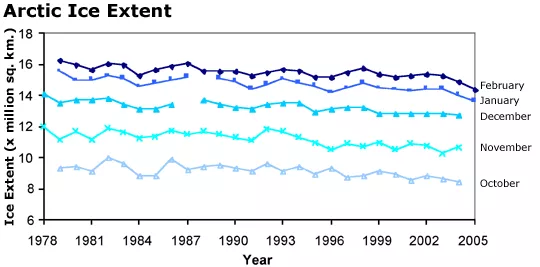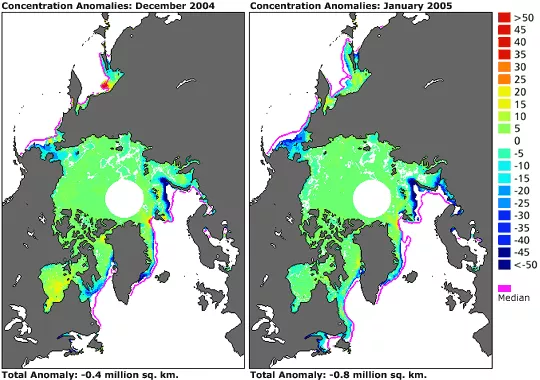By Julienne Stroeve, Florence Fetterer, and Walt Meier
The past three years have witnessed a strong decline in summer ice extent in the Arctic, but ice concentration has rebounded in the winters of 2002-2003 and 2003-2004. The winter of 2004-2005 has been different. Besides a strong summer decline in ice concentration, the Arctic now shows a winter decline as well.
The minimum in Arctic ice extent occurs in September, and since the late 1970s, September sea ice extent has decreased by approximately 20 percent, at a rate of nearly 8 percent per decade. The annual trend has been reported as a decline of approximately 3 percent per decade (Bjørgo et al. 1997, Cavalieri et al. 1997, Parkinson et al. 1999). Now, the wintertime decline alone is approaching 3 percent per decade.
Some studies point to a substantial decrease in the amount of multiyear ice over large areas of the Arctic Ocean, particularly in the western Arctic (Stone et al., in press). Passive microwave records for 1988-2001 indicate a decline of 1.4 percent per year in multiyear ice over the entire Arctic, but a much more pronounced decline of 3.3 percent per year in the southern Beaufort and Chukchi Seas, though with significant interannual variability (Belchansky et al. 2004). Multiyear ice is thicker ice that has survived at least one summer melt season. In order for the volume of Arctic ice to stay about the same from year to year, the multiyear ice that leaves the Arctic — pushed by wind and current circulation patterns through Fram Strait, or succumbing to summer melt — must be replenished by first-year ice that grows in winter and survives the summer. The record minimum sea ice extent of summer of 2002 resulted in the lowest area of surviving first-year ice in recent years (Kwok, 2004). The continued decline in Arctic ice cover has led to speculation that the Arctic Ocean may become completely ice-free in summertime within the current century.
While sea ice extent during September 2002 and 2003 was substantially below the long-term mean, ice extent recovered to near its median position during the following winters. This was not the case following the 2004 September minima: ice extent remained low throughout the 2004-2005 winter, with record low extent observed in December, January and February.
Does the current decline in Arctic sea ice indicate a long-term trend, or is the decline is merely part of a cycle? Both dynamic and thermodynamic processes have contributed to the continued decline in Arctic ice cover. These mechanisms may be partly fueled by rising global temperatures caused by greenhouse gas loading. Lindsay and Zhang (2005) suggest that we may have already reached a new equilibrium state where vast areas of the Arctic will be ice-free during summer. Regardless of whether or not we are now experiencing a new equilibrium state, we can expect further declines in multiyear ice volume if warm temperatures in winter prevent first-year ice from growing sufficiently in extent and thickness to survive the subsequent melt season and thereby replenish multiyear ice lost to export through Fram Strait and to melting. Given the current anomalously low winter sea ice extent, it's reasonable to assume this coming summer will mark another extremely low sea ice extent year.
References
Belchansky, G.I., D.C. Douglas, I.V. Alpatsky, and N.G. Platonov. 2004. Spatial and temporal multiyear sea ice distributions in the Arctic: A neural network analysis of SSM/I data, 1988-2001. J. Geophys. Res 109, C10017, doi: 10.1029/2004JC002388.
Bjørgo, E., O.M. Johannessen, and M.W. Miles. 1997. Analysis of merged SMMR-SSMI time series of Arctic and Antarctic sea ice. Geophys. Res. Lett. 24: 413-416.
Cavalieri, D.J., P. Gloersen, C.L. Parkinson, J.C. Comiso, and H.J. Zwally. 1997. Observed hemispheric asymmetry in global sea ice changes. Science 278, 1104-1106.
Kwok, R. 2004. Annual cycles of multiyear sea ice coverage of the Arctic Ocean: 1999-2003. J. Geophys. Res. 109, C11004, doi:10.1029/2003JC002238.
Lindsay, R.W., and J. Zhang. 2005. The thinning of Arctic sea ice, 1988-2003: Have we passed a tipping point? JP2.19, Proc. Am. Meteorol. Soc. 8th Conf. on Polar Oceanogr. and Meteorol., San Diego, CA, 9-13 January 2005.
Parkinson C.L., D.J. Cavalieri, P. Gloersen, H.J. Zwally, and J.C. Comiso. 1999. Arctic sea ice extents, areas and trends, 1978-1996. J. Geophys. Res. 104(C9): 20837-20856.
Stone, R., D.C. Douglas, G.I. Belchansky, and S.D. Drobot. In press. Correlated declines in western Arctic snow and sea ice cover. Submitted to BAMS.

